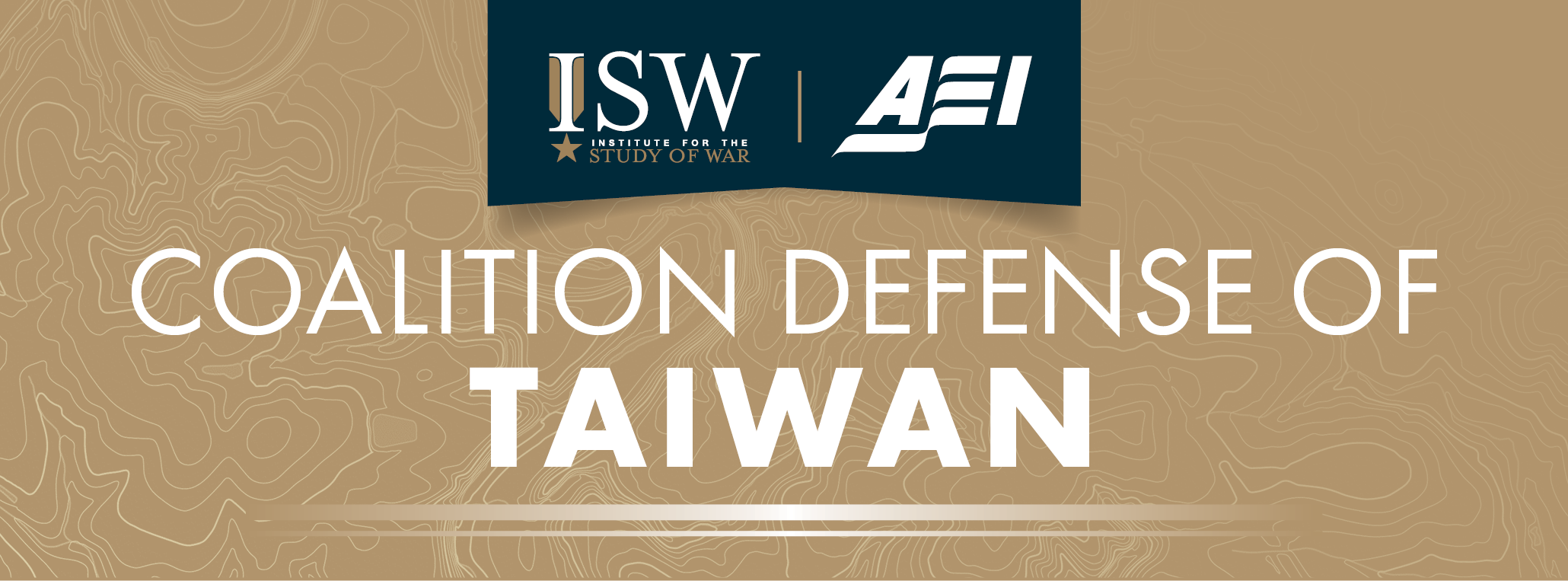 |
 |
Coalition Defense of Taiwan

This page collects links to products and other resources related to the Coalition Defense of Taiwan, a new collaboration between the Institute for the Study of War (ISW) and the American Enterprise Institute (AEI). AEI Senior Fellows Dan Blumenthal and Frederick W. Kagan lead this project.
The Coalition Defense of Taiwan project will examine alternative strategies for the United States and its allies to deter The Chinese Communist Party’s (CCP) aggression and, if necessary, defeat the People’s Liberation Army (PLA). The initiative will assess Chinese campaigns against Taiwan and produce ongoing analysis over the next two years through essays, op-eds, analytical graphics, and strategic assessment reports, which will make recommendations for policymakers to address this major challenge.
The project uniquely combines ISW and AEI’s Asia expertise and the planning exercise methodology used by America’s military (known as PLANEX) to analyze problems at the strategic and operational levels. [Find information on ISW’s past planning exercises here.]
The Coalition Defense of Taiwan project leverages ISW's proven capabilities in open-source intelligence analysis. ISW’s China Analytic Team, consisting of Nils Peterson, Roy Eakin, and Virginia Wang, contribute assessments to this effort alongside AEI’s research team.
Download the one-pager.
The goal of the Coalition Defense of Taiwan is to answer three key questions:
1. How does China threaten Taiwan?
- Our project examines China’s patterns of coercive behavior to identify thresholds for the use of force. By analyzing CCP coercive campaigns, we will expose attempts to split a US-led regional alliance.
2. How could a US-led coalition best deter, counter, or defeat China?
- Our project will identify the CCP’s most likely courses of action. We will use probable CCP courses of action to test and recommend US-led coalition responses.
3. How can the United States form a coalition optimized for deterrence and warfighting?
- We will evaluate the interests and capabilities of potential partners to create an effective coalition. Our reports will identify coalition courses of action that could deter the CCP and defeat PLA invasion scenarios.
Authors: Matthew Sperzel and Daniel Shats of the Institute for the Study of War; Alexis Turek of the American Enterprise Institute
Editors: Dan Blumenthal and Frederick W. Kagan of the American Enterprise Institute
August 21, 2024
The archipelagos of Kinmen and Matsu are uniquely vulnerable among Taiwan’s territories. Both island groups are located over 100 miles from the main island of Taiwan but just off the PRC’s coast: the westernmost of the Matsu islands is around six miles from the PRC, while Kinmen’s main island is as close as two miles from the PRC city of Xiamen. The islands have remained under Republic of China (ROC) control since the Chinese People’s Liberation Army (PLA) under Mao Zedong failed to conquer them at the end of the Chinese Civil War. Kinmen and Matsu remained the primary arenas of PRC–ROC armed conflict from 1955 to 1979. The PRC heavily bombed Kinmen and Matsu during the Taiwan Strait Crises of 1955 and 1958, and both sides intermittently exchanged volleys of both lethal and nonlethal artillery fire until the United States normalized relations with the PRC in 1979.
The PRC continues to claim the islands as its own, as it does with all ROC territories. Its approach to these islands looks very different today, however. The PRC of Xi Jinping is an aspiring superpower whose development is deeply integrated with the global economy; it is far more cautious about military conflict than was the isolated and fanatical regime of Mao Zedong. Beijing’s contemporary efforts to annex Kinmen and Matsu blend economic enticements, nonviolent coercion, legal warfare, information operations, infrastructure construction, and miscellaneous “gray zone” lines of effort to manipulate public opinion on the islands and erode Taiwan’s control of its territories. These efforts are sophisticated and long-term in outlook. They show a Chinese Communist Party (CCP) willing to wait patiently to achieve its goals, but nonetheless making gains that are difficult for Taiwan to reverse.
Taiwan’s presidential election in January 2024 precipitated an escalation of the PRC’s efforts against Taiwan’s outer islands — particularly Kinmen. Although these efforts are still far less dramatic than the bombardments of the 1950s, they may yet prove to be more effective. This paper will lay out the PRC’s lines of effort against Kinmen and Matsu since January 2024 and present a scenario in which an extension of such efforts may evolve into a short-of-war campaign to seize Kinmen within the next six months.
Click here to read the full report
From Coercion to Capitulation, How China Can Take Taiwan Without a War
From Coercion to Capitulation, How China Can Take Taiwan Without a War
Dan Blumenthal, Frederick W. Kagan, Jonathan Baumel, Cindy Chen, Francis de Beixedon, Logan Rank, and Alexis Turek
Strategic debates in the US about Taiwan’s defense have largely centered on how to prevent the PRC from invading and annexing the island. These debates have become especially salient as the Taiwanese people’s unwillingness to join the PRC voluntarily grows and becomes increasingly obvious. The determination of Taiwan’s people to retain their autonomy will encourage PRC leaders to choose more coercive paths to gain control of the island, up to and including invasion and occupation. The US and its allies must certainly prepare for the possibility of a PRC invasion, but they must also prepare for alternative PRC hybrid warfare and coercion strategies.
China’s Three Roads to Controlling Taiwan
March 13, 2023
Dan Blumenthal and Frederick W. Kagan
Key Points:
- China seeks to gain full control of Taiwan through three distinct but interrelated campaigns: forceful persuasion, coercion, and compellence.
- American policy’s focus on compellence marginalizes strategies that counter China’s persuasion and coercion campaigns.
- China is more likely to achieve its goals through persuasion and coercion or a form of compellence, such as a blockade of the island, short of an amphibious invasion.
- The US must urgently rethink its defense of Taiwan so that it blocks all three roads to Chinese victory.